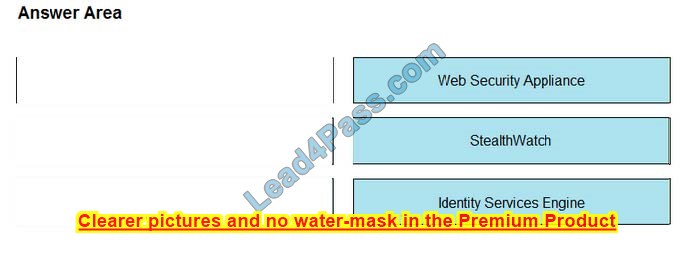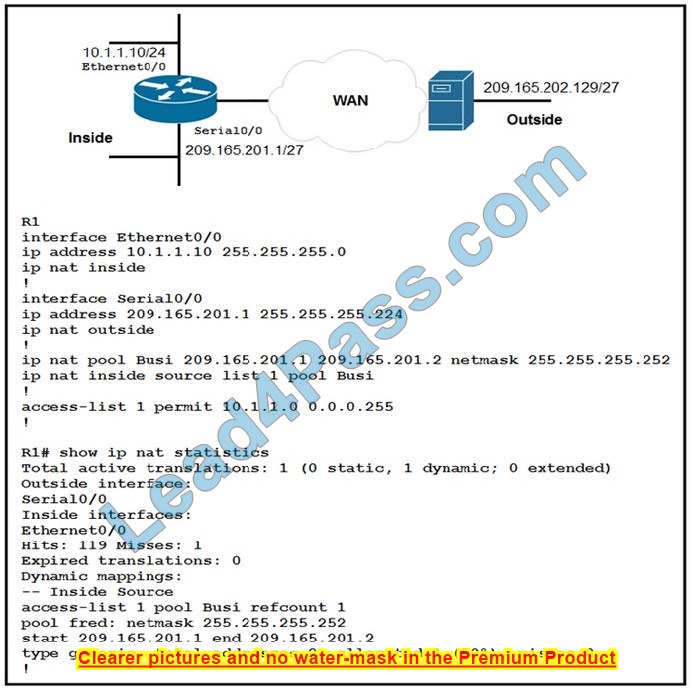leads4pass 350-401 dumps are verified and audited by a Microsoft professional team, and they really meet the requirements of the 350-401 certification exam, covering more than 95% of the exam questions in the exam room!
And, offer the most popular study methods: 350-401 dumps PDF, and 350-401 dumps VCE, both study formats contain the latest certification exam questions and answers!
Therefore, the best exam solution is to use 350-401 dumps with PDF and VCE formats: https://www.leads4pass.com/350-401.html (1051 Q&A), to help you practice easily and achieve exam success.
What’s more! Part of the leads4pass 350-401 dumps exam questions online for free download: https://drive.google.com/file/d/1jt2NnHsnDTx9Mw9iNFudS5KPWyY_fPHM/
You can also practice some of the leads4pass 350-401 dumps exam questions online
| Type | Number of exam questions | Exam name | Exam code | Last updated |
| Free | 15 | Implementing and Operating Cisco Enterprise Network Core Technologies (ENCOR) & CCIE Enterprise Infrastructure & CCIE Enterprise Wireless | 350-401 | 350-401 dumps |
Question 1:
Which definition describes JWT in regard to REST API security?
A. an encrypted JSON token that is used for authentication
B. an encrypted JSON token that is used for authorization
C. an encoded JSON token that is used to securely exchange information
D. an encoded JSON token that is used for authentication
Correct Answer: D
JWT: JSON Web Tokens are an open and standard (RFC 7519) way for you to represent your user\’s identity securely during a two-party interaction. That is to say when two systems exchange data you can use a JSON Web Token to identify your user without having to send private credentials on every request.
Question 2:
What are some of the key differences between HSRPv1 and HSRPv2? (Choose two.)
A. HSRPv1 uses the multicast address of 224.0.0.102 while HSRPv2 uses 225.0.0.2.
B. HSRP uses a group range of 0-255, while HSRP uses a group range of 0-4095.
C. HSRPv1 uses seconds-based timers, while HSRPv2 uses milliseconds-based timers.
D. HSRPv1 provides support for IPv6, while HSRPv2 supports IPv4 only.
Correct Answer: BC
should be HSRPv1, HSRPv2
Question 3:
Refer to the exhibit.

Which command must be applied to Routed to bring the GRE tunnel to an up/up state?
A. Router1(config)#interface tunnel0
B. Router1(config-if)#tunnel source GigabitEthernet0/1
C. Router1(config-if)#tunnel mode gre multipoint
D. Router1(config-if)#tunnel source Loopback0
Correct Answer: D
Question 4:
By default, which virtual MAC address does HSRP group 32 use?
A. 00:5e:0c:07:ac:20
B. 04:18:20:83:2e:32
C. 05:5e:5c:ac:0c:32
D. 00:00:0c:07:ac:20
Correct Answer: D
The virtual IP resolves to a virtual MAC address in the format 0000.0c07.acxx, xx being the group number in hexadecimal. For example, if you use group number 3, the last part of the MAC address is ac03. 32 is in binary 0010 0000 that\’s mean in HEX its 2 0
Question 5:
Which two methods are used to reduce the AP coverage area? (Choose two.)
A. Increase minimum mandatory data rate
B. Reduce AP transmit power
C. Disable 2.4 GHz and use only 5 GHz.
D. Enable Fastlane.
E. Reduce channel width from 40 MHz to 20 MHz
Correct Answer: AB
Reducing the channel width does not affect directly the coverage area. Settings the transmit power and increases the minimum data rate do.
Question 6:
What is YANG used for?
A. scraping data via CLI
B. processing SNMP read-only polls
C. describing data models
D. providing transport for network configuration data between client and server
Correct Answer: C
YANG is used to model each protocol based on RFC 6020.
Question 7:
DRAG DROP
Drag and drop the solutions that comprise Cisco Cyber Threat Defense from the left onto the objectives they accomplish on the right.
Select and Place:

Correct Answer:

Question 8:
Refer to the exhibit.

An engineer is installing a new pair of routers in a redundant configuration.
Which protocol ensures that traffic is not disrupted in the event of a hardware failure?
A. HSRPv1
B. GLBP
C. VRRP
D. HSRPv2
Correct Answer: A
The virtual MAC address is 0000.0c07.acXX (XX is the hexadecimal group number) so it is using HSRPv1. Note: HSRP Version 2 uses a new MAC address which ranges from 0000.0C9F.F000 to 0000.0C9F.FFFF.
Question 9:
Refer to the exhibit.

Object tracking has been configured for VRRP-enabled routers Edge-01 and Edge-02 Which commands cause Edge-02 to preempt Edge-01 in the event that interface G0/0 goes down on Edge-01?
A. Edge-01(config)#interface G0/1 Edge-01(config-if)#vrrp 10 track 10 decrement 30
B. Edge-02(config)#interface G0/1 Edge-02(config-if)#vrrp 10 track 10 decrement 30
C. Edge-02(config)#interface G0/1 Edge-02(config-if)#vrrp 10 track 10 decrement 10
D. Edge-01(config)#interface G0/1 Edge-01(config-if)#vrrp 10 track 10 decrement 10
Correct Answer: A
Question 10:
While configuring an IOS router for HSRP with a virtual IP of 10.1.1.1, an engineer sees this log message.
Jan 1 12:12:12.111 : %HSRP-4-DIFFVIP1: GigabitEthernet0/0 Grp 1 active routers virtual IP address 10.1.1.1 is different to the locally configured address 10.1.1.25
Which configuration change must the engineer make?
A. Change the HSRP group configuration on the remote router to 1.
B. Change the HSRP group configuration on the local router to 1.
C. Change the HSRP virtual address on the remote router to 10.1.1.1.
D. Change the HSRP virtual address on the local router to 10.1.1.1.
Correct Answer: D
Syslog points to local router having VIP ip 10.1.1.25, and remote router in g0/0 interface having 10.1.1.1. We want latter to all routers in HSRP so we need to configure local router, hence B. “is different to the locally configured…”
Question 11:
Refer to the exhibit.

A network administrator configured RSPAN to troubleshoot an issue between switchl and switch2. The switches are connected using interface GigabitEthernet 1/1 An external packet capture device is connected to swich2 interface GigabitEthernet1/2 Which two commands must be added to complete this configuration? (Choose two)
A. switch2(config-if)# switchport trunk allowed vlan 10,20,30,40,50,60,70-80
B. switch2(config)# monitor session 1 source remote vlan 70 switch2(config)# monitor session 1 destination interface GigabitEthernet1/2
C. switch1(config)# interface GigabitEthernet 1/1 switch1(config-if)# switchport mode access switch1(config-if)# switchport access vlan 10 switch2(config)# interface GigabitEthernet 1/1 switch2(config-if)# switchport mode access switch2(config-if)# switchport access vlan 10
D. switch2(config)# monitor session 2 destination vlan 10
E. switch2(config)# monitor session 1 source remote vlan 70 switch2(config)# monitor session 1 destination interface GigabitEthernet1/1
Correct Answer: AB
Question 12:
Refer to the exhibit.

An engineer is using XML in an application to send information to a RESTCONF-enabled device. After sending the request, the engineer gets this response message and an HTTP response code of 400. What do these responses tell the engineer?
A. The Accept header sent was application/xml
B. POST was used instead of PUT to update
C. The Content-Type header is sent as application/xml.
D. JSON body was used
Correct Answer: C
Question 13:
Which Cisco FlexConnect state allows wireless users that are connected to the network to continue working after the connection to the WLC has been lost?
A. Authentication Down/Switching Down
B. Authentication-Central/Switch-Local
C. Authentication- Down/Switch-Local
D. Authentication-Central/Switch-Central
Correct Answer: C
Operation Modes
There are two modes of operation for the FlexConnect AP.
*
Connected mode: The WLC is reachable. In this mode, the FlexConnect AP has CAPWAP connectivity with its WLC.
*
Standalone mode: The WLC is unreachable. FlexConnect has lost or failed to establish CAPWAP connectivity with its WLC. A WAN-link outage between a branch and its central site is an example of such a mode of operation.
FlexConnect States
A FlexConnect WLAN, depending on its configuration and network connectivity, is classified as being in one of the following defined states.
*
Authentication-Central/Switch-Central: This state represents a WLAN that uses a centralized authentication method such as 802.1X, VPN, or web. User traffic is sent to the WLC via CAPWAP (Central switching). This state is supported only when FlexConnect is in connected mode.
*
Authentication Down/Switching Down: Central switched WLANs no longer beacon or respond to probe requests when the FlexConnect AP is in standalone mode. Existing clients are disassociated.
*
Authentication-Central/Switch-Local: This state represents a WLAN that uses centralized authentication, but user traffic is switched locally. This state is supported only when the FlexConnect AP is in connected mode.
*
Authentication-Down/Switch-Local: A WLAN that requires central authentication rejects new users.
Existing authenticated users continue to be switched locally until session time-out is configured. The WLAN continues to beacon and respond to probes until there are no more existing users associated with the WLAN. This state occurs as a result of the AP going into standalone mode.
*
Authentication-local/switch-local: This state represents a WLAN that uses open, static WEP, shared, or WPA2 PSK security methods. User traffic is switched locally. These are the only security methods supported locally if a FlexConnect goes into standalone mode. The WLAN continues to beacon and respond to probes. Existing users remain connected and new user associations are accepted. If the AP is in connected mode, authentication information for these security types is forwarded to the WLC.
Question 14:
Refer to my exhibit.

What is the cause of the log messages?
A. hello packet mismatch
B. OSPF area change
C. MTU mismatch
D. IP address mismatch
Correct Answer: B
Question 15:
Refer to the exhibit.

A network engineer configures NAT on R1 and enters the show command to verify the configuration. What does the output confirm?
A. The first pocket triggered NAT to add on entry to NAT table
B. R1 is configured with NAT overload parameters
C. A Telnet from 160.1.1 1 to 10.1.1.10 has been initiated.
D. R1 to configured with PAT overload parameters
Correct Answer: A
…
leads4pass 350-401 dumps share two study materials for free: you can download them online and practice exams online!
Now! Download the 350-401 best practice solution! Use leads4pass 350-401 dumps with PDF and VCE: https://www.leads4pass.com/350-401.html Contains the 1051 latest exam questions and answers to help you pass the exam 100%.
